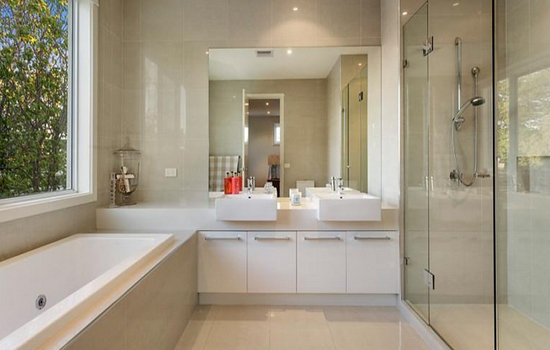The works involve replacement of tiles, ceilings, windows, lighting, power, sanitary ware, and brassware and ventilation systems. The renovator may opt to replace all items entirely or some of the components. Appropriate tools such as a chisel, mallet and spanners are used during removal of existing tiles on walls and floors, sanitary ware and brassware. This caution is practiced to protect existing plumbing and drainage pipework as well as power conduits. Caution is necessary when dealing with fragile items that could be re-installed or re-sold.
The bathroom layout rearrangement takes place here. The positions of water closets, hand wash sinks and bathtubs should be planned to give enough space between fittings. Ideally, there should be 400mm between any two sanitary fittings. The placement of accessories should allow the flow of activities in the bathroom as well as ease of opening doors. The shower area should have minimum dimensions of 1 meter by 1 meter. It must have a good drainage and showerheads should not eject too much water to avoid spills.

All plumbing works are chased in the floor for drainage pipes or concealed inside the wall for plumbing pipes and mixers. The drainage pipes, floor traps, and drains must undergo testing for leakages and slopes. Note that in areas that experience freezing, plumbing pipes should be steel or copper to alleviate the cracking problem.
Tiles are then neatly fixed to leave provision for fitting, sanitary ware and brassware. Wall tiles should be plumb while floor tiles should slope towards drains and floor traps. The color, size, texture and feel of the tiles depend on user tastes and preferences. Favorite floorings include Ceramic, Marble, Hardwood and Stone tiles.
Emphasis on firmness guides the fitting of sanitary ware and brassware. All imperfections in the joints between the fixtures and tiles are covered. User preferences inspire choice of sanitary ware. However, purchase rust free taps and faucets. The bath tub must be spacious with a comfortable incline. Handmade bath products are must-have accessories that enhance one’s personal touch to the work.
Proper lighting that complements the ceiling design is done. Lights can be surface mounted or recessed into ceilings e.g. LED lights are fixed in gypsum ceilings. All bathroom lights should be IP rated against moisture. A classy mirror is also an important bathroom accessory.
It is important that bathrooms are well ventilated. Keeping windows open is a natural remedy while the use of extract fans is an artificial solution. Extract fans are either wall mounted or fixed on the ceiling with a duct terminating to the open air. If there is no centralized water heating (boiler or solar cylinder) instantaneous water heaters are installed under sinks or in ceiling voids.
